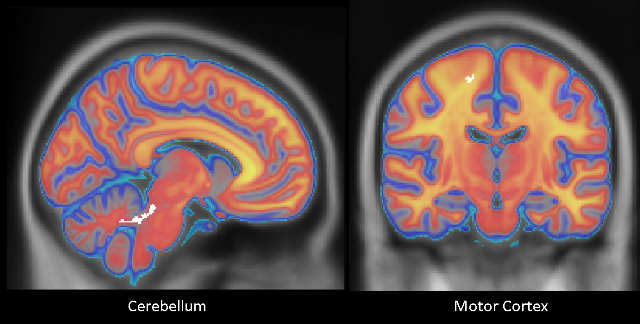Researchers from Imperial College London and University College London are taking their shot at it. They took brain scans which revealed distinctive features in the brain structure of martial arts experts, which they say could be linked to their ability to punch powerfully from close range.
Those differences in the structure of white matter – the connections between brain regions – were correlated with how black belts and novices performed in a test of punching ability.
Bruce Lee, of course, has become almost mythological in tales about how much power he generated from minute distances. Force = Mass X Acceleration, though, so it may be he just had the ability to accelerate without needing a lot of space. It also may be that, like Babe Ruth hitting 600 foot home runs, the legend is better than the science reality.
Push or punch? The debate rages on almost four decades after he died.
Martial arts experts, especially the lower-centered hand technique kind like Karate and others, are able to generate extremely powerful forces with their punches - that can be measured easily but just how they do this is not fully understood. As we note in the paragraph above, the force generated in a karate punch is not determined by muscular strength or mass alone, so if it is related to acceleration, the brain factors related to the control of muscle movement are important - like knowing how Usain Bolt can jog at the end and still win a race in the Olympics, this knowledge won't help you break cinder blocks, but at least it might tell you why you can't.
Their study looked for differences in brain structure of 12 karate practitioners with a black belt rank and an average of 13.8 years of experience and then a control group of 12 subjects of similar age who exercised regularly but did not have any martial arts experience. The researchers tested how powerfully the subjects could punch, but to make useful comparisons with the punching of novices they restricted the task to punching from short range – a distance of 5 centimeters, about 2 inches. The subjects wore infrared markers on their arms and torso to capture the speed of their movements.

(A) Infrared markers on the radius and ulna bones of the wrist, on the elbow and the shoulder of each arm, (B) on either side of the hips (the iliac crests), and along the midline at the level of lumbar vertebra L5 and cervical vertebra C7. The participants stood on a floor force plate and, in the punching tasks, struck a vertical force plate with their right hand. (C) Mean velocity profiles for the expert group, immediately before and after punching on the 5 cm task. (D) The temporal difference between the peak velocities of the wrist and shoulder of the right hand when punching from a distance of 5 cm was significantly smaller in the karate expert group (blue) and the controls (white). Credit and link: Cerebral Cortex
As anyone would predict, the karate group punched harder and the power of their punches seemed to be down to timing: the force they generated correlated with how well the movement of their wrists and shoulders were synchronized. But that is just muscle memory and training, right? Just like a professional striker in soccer would have a hard time looking like he was trying but then missing the goal.
Yet brain scans showed that the microscopic structure in certain regions of the brain differed between the two groups. Each brain region is composed of gray matter, consisting of the main bodies of nerve cells, and white matter, which is mainly made up of bundles of fibers that carry signals from one region to another. The scans used in this study, called diffusion tensor imaging (DTI), detected structural differences in the white matter of parts of the brain called the cerebellum and the primary motor cortex, which are known to be involved in controlling movement.

The locations in the cerebellum and motor cortex where there were differences between the groups. Credit: Imperial College London
The differences measured by DTI in the cerebellum correlated with the synchronicity of the subjects’ wrist and shoulder movements when punching. The DTI signal also correlated with the age at which karate experts began training and their total experience of the discipline. These findings suggest that the structural differences in the brain are related to the black belts’ punching ability.
“Most research on how the brain controls movement has been based on examining how diseases can impair motor skills,” said Dr Ed Roberts, from the Department of Medicine at Imperial College London, who led the study. “We took a different approach, by looking at what enables experts to perform better than novices in tests of physical skill. The karate black belts were able to repeatedly coordinate their punching action with a level of coordination that novices can’t produce. We think that ability might be related to fine tuning of neural connections in the cerebellum, allowing them to synchronise their arm and trunk movements very accurately. We’re only just beginning to understand the relationship between brain structure and behaviour, but our findings are consistent with earlier research showing that the cerebellum plays a critical role in our ability to produce complex, coordinated movements.
“There are several factors that can affect the DTI signal, so we can’t say exactly what features of the white matter these differences correspond to. Further studies using more advanced techniques will give us a clearer picture.”
Citation; R.E. Roberts, P.G. Bain, B.L. Day and M. Husain, 'Individual Differences in Expert Motor Coordination Associated with White Matter Microstructure in the Cerebellum', Cereb. Cortex (2012) First published online: August 14, 2012 doi: 10.1093/cercor/bhs219 (FREE TO READ)






Comments